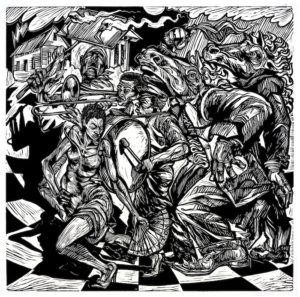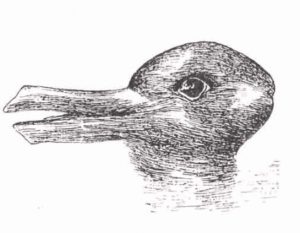The things that Prince depicts in his artwork pertain to mature subjects but looking at his work also reminds me of my childhood. I used to play these “I Spy” games on the family computer in which the player simply tried to find and click on all of the items that were listed for the player to find. I’m not sure why 6-year-old me was so entertained by this, but I used to play for hours—just how I feel like one could view Prince’s artwork for hours and still make new discoveries.
Dr. Nicodemi’s lecture on perspective was fascinating to me. I learned that the way a piece of art looks can completely change just based on where you are viewing it from. Dr. Nicodemi explained to our class that each piece of art has its own specific viewing distance and when it’s viewed at this particular angle it is as if the viewer is in the painting and becomes a part of it. But the viewpoint doesn’t always go back into space, sometimes the art seemingly doesn’t want you to be a part of it. This is the case in Prince’s Flambeau. It is as if the subjects are trying to burst out of the painting, leaving no room for the viewer to get inside of it.

Just how there are different ways to view a piece of art there are also varying interpretations that can be made. What we see and notice is going to be impacted by our own personal experiences and biases. It’s possible that we all have the capability to notice everything that could be noticed, but the order that we notice each thing will vary depending on each person. Some things are more impactful than others for different people. For example, In Alexis’ post “The Perplexing Dove” Alexis wrote: “When we presented our discoveries and our questioning, I exclaimed how I wanted to cut open that box and have the dove fly in the sky. But why? Why did I have this interpretation that the dove was entrapped? Others in the class had different interpretations.” I remember how frustrated she was by how she couldn’t understand what the dove meant, so it makes sense that she wrote a blog post unpacking her own interpretation. I also find that writing out something that is in my head allows me to think through it more thoroughly. But while Alexis viewed the dove as trapped, Kazon pointed out the possibility that the dove was free and was in that box of its own free will. Just because Alexis and Kazon’s interpretations oppose each other does not mean that they are not both valid.
I love hearing my classmates varying interpretations because I often find myself saying “Wow, I didn’t even notice that!” While I love hearing these interpretations, I also recognize that it can sometimes be hard to not get trapped in your own perspective. An example I can think of to describe this simply is those drawings that can double as two images. While one person might immediately see a duck in this image below, another person could see a rabbit.

In my experience once I have seen one thing it’s hard to see the other, but if you look closely enough the second image will reveal itself. If you’re open to changing your standpoint then you’ll be able to understand other people’s perspectives, don’t be so trapped in your own position on something or else you’ll only have access to a glimpse of what art has to offer. Sarah said something similar to this in her post titled “A Matter of Perspective” Sarah said, “What stands out to me is that the way I understand and evaluate topics are often very different from the viewpoints and analysis of other students in my class. I see and understand things the way Sarah-Anne Michel only could, and this unique perspective can be translated in almost any subject, idea, project that I venture on. But what I have learned recently is that although I may never share the exact same perspective as those around me, it is possible to exercise my mind to be open to seeing things in perspective of others.” As Sarah says, opening your mind to new perspectives is an exercise, but I think it’s worth it.
Besides individual perspectives, there’s other more technical components that can influence how we view a piece of art. For example, Cynthia Hawkins-Owen talked about how she has to “spot the work,” meaning she has to place the works in a way that the viewer has the best experience. As an art gallery director, Hawkins-Owen has to ensure that the movement, direction, and color of a collection is harmonious. When different pieces are placed next to one another it’s possible to fall into the trap of placing them in a way where the viewer’s eye moves from right to left or vice versa. Hawkins-Owen said the experience is meant to be more active than this—the pieces should drag the viewer’s eyes in both directions. It was interesting to learn all the things Hawkins-Owen has to keep in mind when she is staging a new collection of artworks so that the viewers experience with the art is not inhibited.
The artist and the people like Cynthia Hawkins-Owen do so much work just so art can be viewed that I think it would be shameful to not notice as much as you can and even talk about the seemingly trivial aspects of the work. Even if something doesn’t have meaning we can talk about how it doesn’t have meaning. Both Cynthia Hawkins-Owen and Steve Prince believe that art is supposed to be a “vehicle for discussion.” I liked Lindsey’s way of describing this in her post “What’s Black and White, but Gray All Over?” Lindsey said, “As Prince stated in the aforementioned quote; “the work has different meanings… [when encountered at different cognitive points in one’s life]”. What the viewer focuses on, what the viewer doesn’t focus on, what knowledge the viewer holds, what the viewer has experienced, what the viewer knows about Prince—these questions are all at play when one experiences Prince’s work.” All these components present opportunities for discussion that could change the world.
